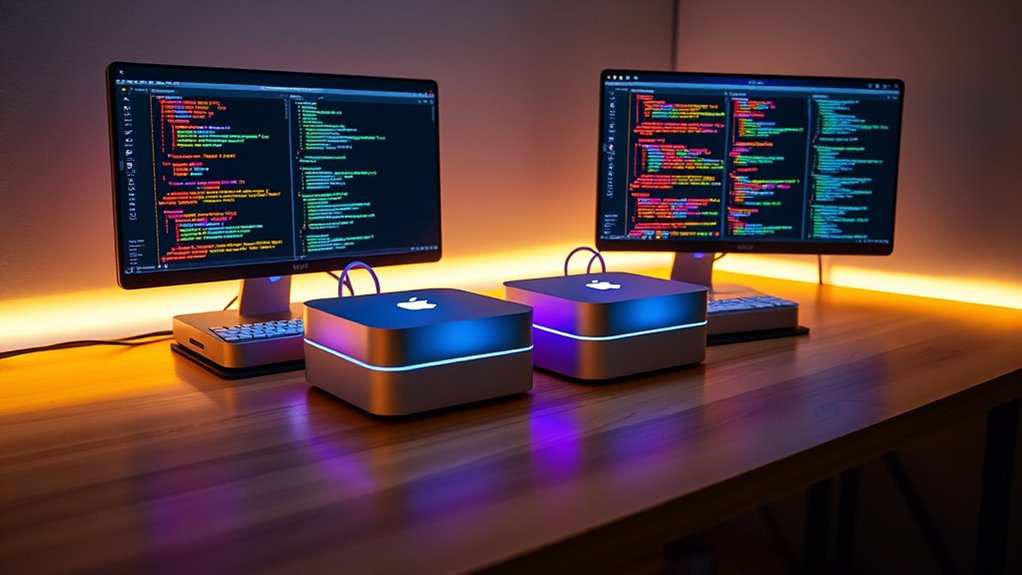If you’re looking to boost your coding game in 2025, the Mac mini options with M4 Pro and M4 chips are excellent choices. They offer powerful performance, multiple ports, and compact designs perfect for tight spaces or portable setups. With up to 24GB RAM and fast SSDs, they handle demanding tasks smoothly. Want to find out which one best fits your needs? Keep going to discover more details.
Key Takeaways
- Look for Mac Minis with the latest M4 Pro chip for optimal processing power and multitasking capabilities.
- Prioritize models with at least 16GB of unified memory to efficiently run IDEs, emulators, and development tools.
- Ensure multiple Thunderbolt 4/USB-C ports, HDMI, and Ethernet for external device connectivity and multi-monitor setups.
- Consider energy-efficient, quiet models suitable for long coding sessions and demanding workloads.
- Balance price and expandability, opting for external drives and hubs to enhance storage and connectivity options.
Apple Mac mini Desktop Computer with M4 Pro chip
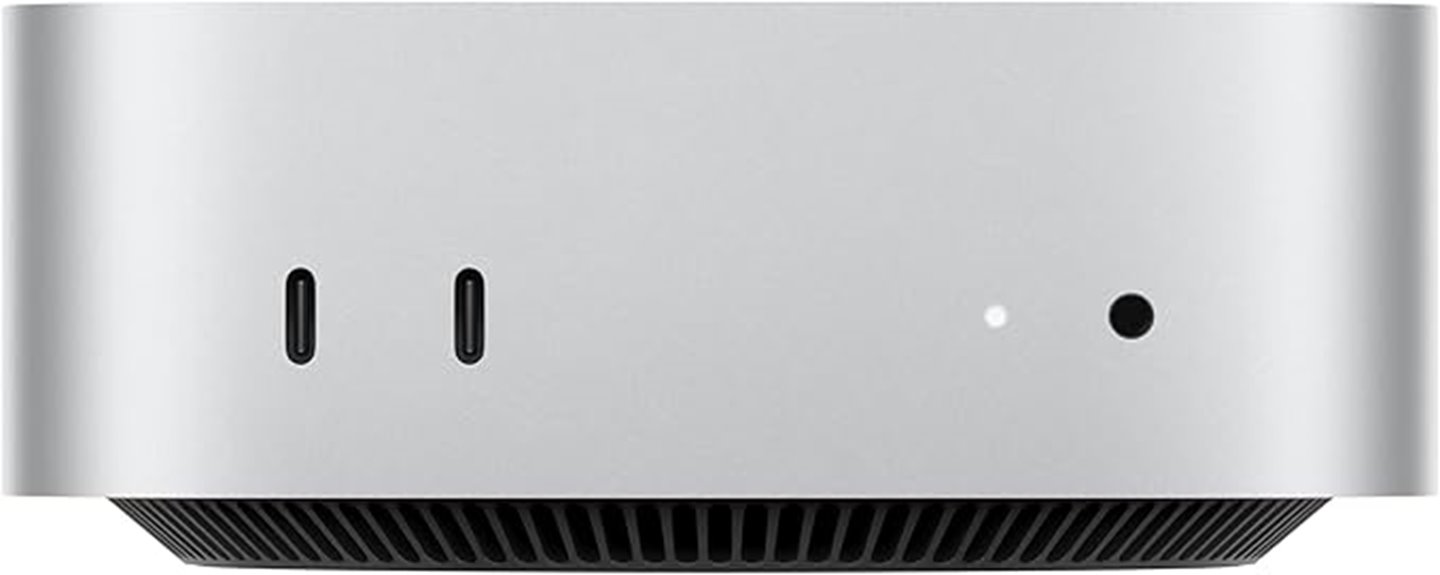
If you’re looking for a compact desktop that doesn’t compromise on power, the Apple Mac mini with the M4 Pro chip is an excellent choice for software developers. Its small footprint—just 5×5 inches—fits perfectly beside monitors or in tight spaces. Powered by the M4 Pro chip, it offers a 12-core CPU and 16-core GPU, delivering lightning-fast performance for demanding tasks. With 24GB of unified memory and a 512GB SSD, it handles large projects smoothly. Connectivity is robust, including Thunderbolt, HDMI, and USB-C ports. Overall, this Mac mini combines size, speed, and efficiency, making it ideal for developers who need desktop-level power in a tiny package.
Best For: software developers and tech enthusiasts who need a powerful, compact desktop that can handle demanding tasks with ease.
Pros:
- Compact size fits easily in tight spaces or next to monitors
- Powerful M4 Pro chip with a 12-core CPU and 16-core GPU ensures fast performance
- Ample 24GB unified memory and 512GB SSD for smooth multitasking and large project handling
Cons:
- Limited storage options may require external drives for larger data needs
- No dedicated graphics card option; reliant on integrated GPU for graphics performance
- Price point may be higher compared to other compact desktops with similar specs
Apple Mac mini Desktop Computer with M4 Chip (2024)

The Apple Mac mini Desktop Computer with M4 Chip (2024) stands out as an ideal choice for developers who need powerful performance in a compact form factor. Its small, five-by-five-inch design fits easily next to a monitor, saving space without sacrificing power. Equipped with the M4 chip’s 10-core CPU, GPU, and Neural Engine, it delivers fast app launches and smooth multitasking. With up to 32GB of unified memory and fast SSD storage, it handles coding, media, and light editing effortlessly. Connectivity options, including Thunderbolt 4 and HDMI, support multiple displays, making it versatile. Its quiet, cool operation and seamless integration with macOS and Apple ecosystem make it a compelling, space-saving development machine.
Best For: developers, creatives, and professionals seeking a compact, powerful, and energy-efficient desktop for coding, media editing, and multitasking.
Pros:
- Compact size fits easily next to monitors and in tight spaces
- Fast performance with M4 chip, ideal for multitasking and media tasks
- Quiet and cool operation enhances user experience and reduces noise
Cons:
- Non-upgradable RAM and storage may require external drives for expansion
- Limited ports compared to larger workstations, potentially requiring adapters
- Higher initial cost for maximum configurations and accessories
Apple Mac mini Desktop Computer with M4 Chip (256GB SSD, 16GB RAM)
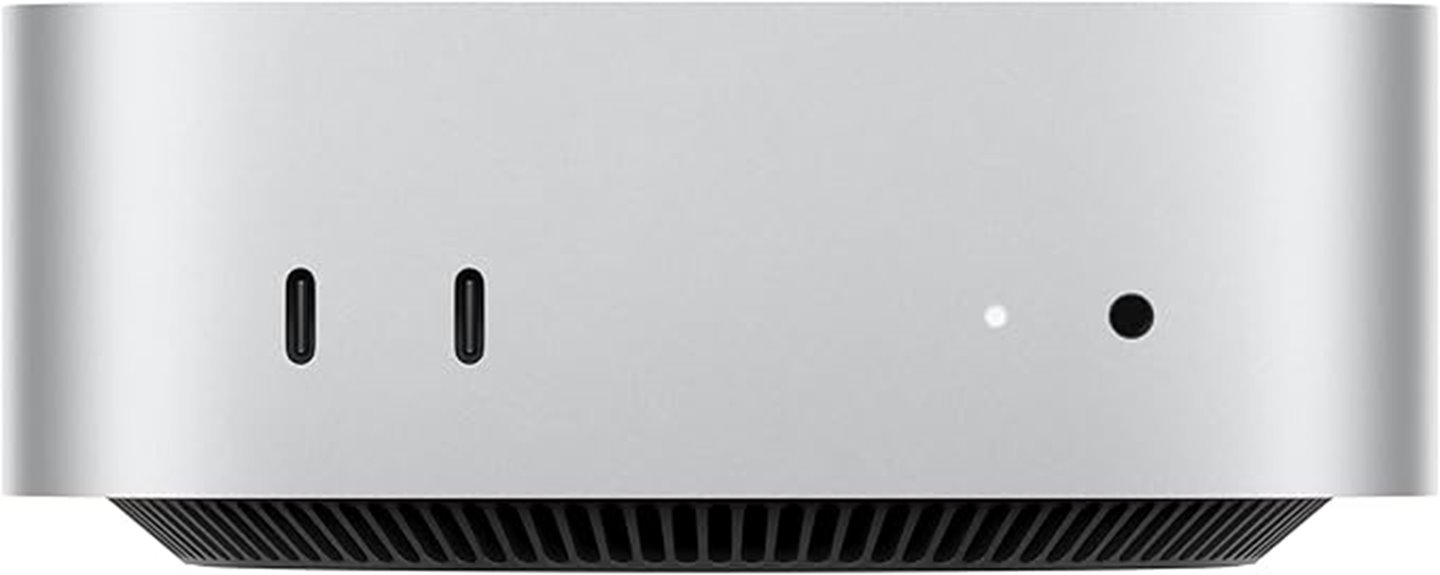
For software developers seeking a compact yet powerful workstation, the Apple Mac mini with M4 chip, 256GB SSD, and 16GB RAM stands out as an excellent choice. Its small five-by-five-inch design fits easily on any desk, yet it delivers impressive performance thanks to the 10-core M4 processor and 16GB of unified memory. The device runs quietly and stays cool under load, making it ideal for long coding sessions. With support for up to three displays and fast connectivity options, it handles multitasking and demanding applications effortlessly. This Mac mini offers a perfect balance of size, power, and efficiency for developers who value space-saving design without sacrificing performance.
Best For: software developers and creative professionals seeking a compact, silent, and powerful desktop that seamlessly integrates with the Apple ecosystem.
Pros:
- Compact and space-efficient design ideal for small desks and limited workspace
- Powerful M4 chip with 10-core CPU and GPU delivers excellent performance for multitasking and demanding applications
- Quiet operation with minimal heat generation, perfect for long work sessions
Cons:
- Non-upgradable RAM and storage limit future expansion options
- Limited ports on the front, requiring adapters or hubs for additional peripherals
- 256GB SSD may be insufficient for heavy storage needs without external solutions
Apple Mac mini Desktop Computer with M4 Chip (512GB SSD, 24GB RAM)
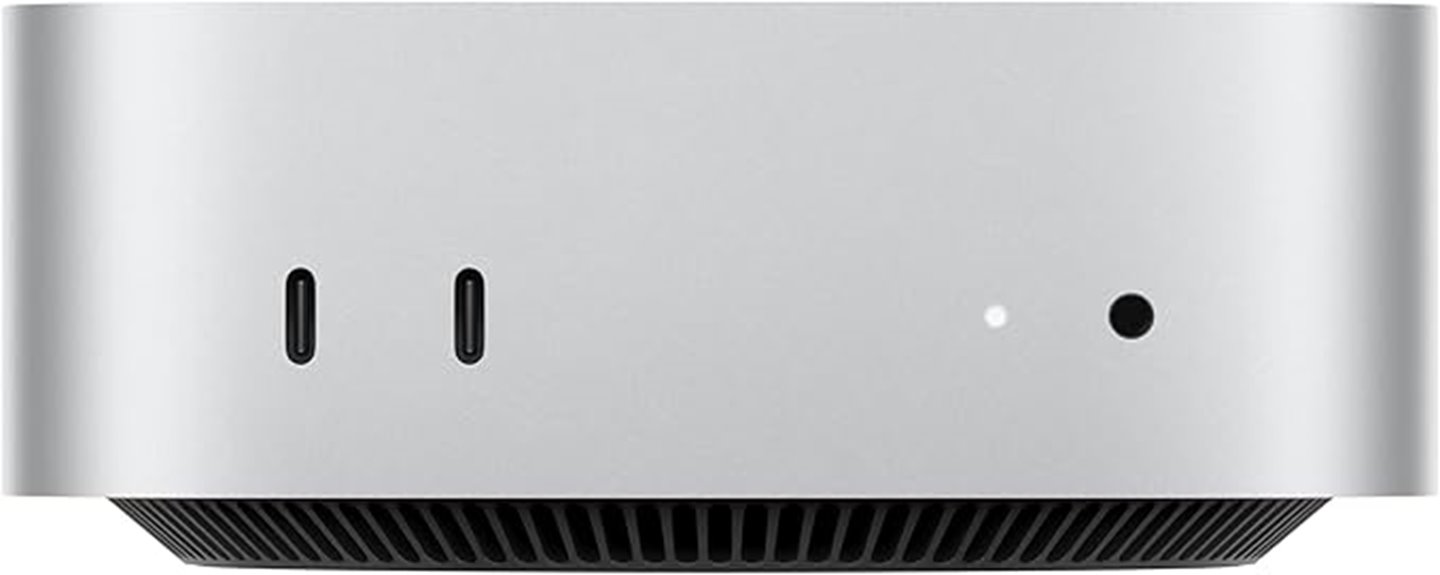
The Apple Mac mini with M4 chip, 512GB SSD, and 24GB of RAM stands out as a powerful and compact option for serious software developers seeking a reliable desktop that fits seamlessly into any workspace. Its small five-by-five-inch size packs a punch with a 10-core CPU, 10-core GPU, and unified memory, ensuring swift multitasking and fast app responsiveness. The sleek design keeps noise and heat minimal, while front and back ports provide ample connectivity, supporting multiple displays and high-speed data transfer. Perfect for creative coding, light video editing, or automation tasks, this Mac mini offers impressive performance in a space-efficient package.
Best For: software developers, creative professionals, and users needing a compact yet powerful desktop for multitasking and multimedia tasks.
Pros:
- Compact, space-saving design that fits easily into any workspace
- Powerful M4 chip with 10-core CPU and GPU delivers fast performance
- Supports multiple high-resolution displays and fast data transfer
Cons:
- Non-upgradable RAM and storage limits future expandability
- Limited port selection may require external hubs for additional connectivity
- Slightly higher price point compared to traditional desktops with similar specs
Factors to Consider When Choosing a Mac Mini for Software Development
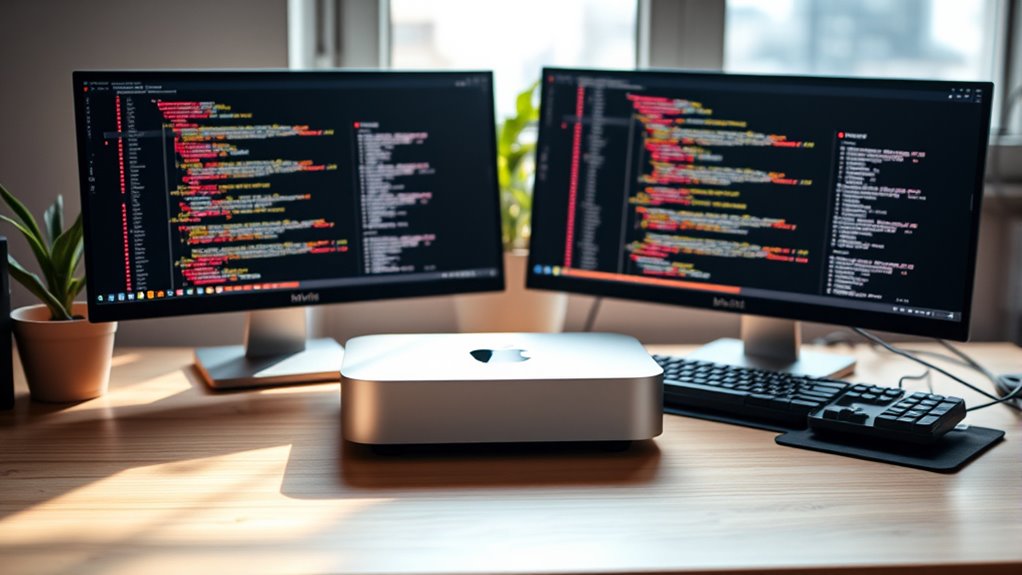
When selecting a Mac Mini for software development, I focus on processing power, memory, and storage to guarantee smooth performance. I also consider connectivity options and compatibility with my tools, along with size and portability for my workspace. Understanding these factors helps me choose a machine that keeps my coding efficient and hassle-free.
Processing Power Needs
Choosing a Mac Mini for software development means paying close attention to processing power, as it directly impacts your productivity. Tasks like compiling code, running virtual machines, and testing applications thrive with higher CPU core counts. A multi-core processor, such as a 10-core or 12-core CPU, can drastically cut build times and enhance multitasking efficiency. For more demanding work like mobile app development or managing large databases, a robust GPU and ample RAM make a real difference in responsiveness and performance. Hardware-accelerated features like ray tracing and media engines also speed up multimedia tasks within your environment. Additionally, ensuring your processor supports native virtualization and fast data transfer speeds helps streamline testing and deployment workflows, making a powerful processor essential for a smooth, efficient development experience.
Memory and Storage Capacity
Adequate memory and storage are crucial for smooth software development, as they determine how many applications, IDEs, and virtual machines you can run simultaneously without lag. I recommend a minimum of 16GB of unified memory for most tasks, but 24GB or more is optimal for intensive workloads like large datasets or complex virtual environments. Sufficient storage, such as 512GB or higher, ensures space for large codebases, datasets, and multiple tools without constant management. Fast SSDs greatly reduce load times and boost system responsiveness, making development more efficient. Also, consider future needs; opt for a device that supports external drives or cloud storage to expand capacity as your projects grow. Balancing memory and storage is key to a seamless development experience.
Connectivity Options
Connectivity options substantially impact how efficiently your Mac Mini supports a robust software development environment. I look for models with multiple Thunderbolt 4/USB-C ports, ensuring high-speed data transfer and ample connections for peripherals. HDMI and Gigabit Ethernet ports are essential for external displays and reliable network connectivity, so I verify their presence. To expand my setup, I prefer Macs that support external USB-C hubs or docks, enabling additional monitors, storage, and accessories. Compatibility with external drives, especially fast SSDs, is vital for testing and data management. Finally, I prioritize models with advanced wireless options like Wi-Fi 6E and Bluetooth 5.3, which facilitate seamless connection to peripherals and development tools. These connectivity features streamline my workflow and keep my development environment flexible and efficient.
Compatibility With Tools
When selecting a Mac mini for software development, I make sure it supports the latest macOS version required by my tools and software. Compatibility is vital, so I verify that the device has enough RAM and processing power to run IDEs, emulators, and compilers smoothly. I also check if it supports specialized development tools, libraries, and SDKs that might need specific hardware features or architecture. Ensuring compatibility with peripheral devices, like multiple monitors and USB hardware, is essential for an efficient workflow. If I need to run different operating systems or isolated environments, I confirm that virtualization or containerization software works well on the device. Overall, matching the Mac mini’s capabilities with my development needs helps prevent roadblocks and boosts productivity.
Size and Portability
If portability is a priority, the Mac mini’s compact five-by-five-inch size makes it an excellent choice for developers who need to maximize space and flexibility. Its small footprint allows it to sit neatly next to monitors or in tight workspace setups, helping keep desks clutter-free. Weighing around 1.5 pounds, it’s easy to move and reposition, making it suitable for developers who work across multiple locations or need a mobile setup. Despite its small size, the Mac mini packs powerful hardware options, so portability doesn’t come at the expense of performance. Its lightweight, easy-to-carry design makes it ideal for on-the-go work, whether in a coffee shop, co-working space, or during travel. This blend of size and portability enhances versatility for any developer’s workflow.
Frequently Asked Questions
How Does the Mac Mini Compare to Other Apple Silicon Options for Development?
The Mac Mini offers a compact, affordable option that’s perfect for development, especially with the latest Apple Silicon chips. Compared to MacBook Pros or iMacs, it’s more customizable and space-efficient, but still delivers powerful performance. I find it ideal for multitasking and running demanding applications. While the MacBook Pros offer portability, the Mac Mini strikes a great balance between power and desk space, making it my top choice for a dedicated development machine.
Can the Mac Mini Support Multiple Monitors Effectively for Coding Workflows?
Yes, the Mac Mini can support multiple monitors effectively for coding workflows. I’ve used it with dual displays, and it handles them smoothly, especially with the M2 or M2 Pro chips. The Thunderbolt and HDMI ports give me flexibility to connect high-resolution screens without any lag. It’s a great setup for multitasking, debugging, and managing multiple coding windows, making my workflow more efficient and organized.
What Are the Upgrade Options Available After Purchasing a Mac Mini?
Sure, I can upgrade my Mac Mini—at least, a little. You can bump up the RAM (up to 64GB) and swap out the storage for a faster SSD. However, the CPU and GPU are soldered, so those stay put. I love that Apple makes upgrades possible, but it’s a reminder that some parts are just for show. Still, those upgrades keep my Mac Mini relevant for longer.
How Does the Mac Mini’s Thermal Performance Impact Long Coding Sessions?
The Mac Mini’s thermal performance really affects my long coding sessions. When it runs cool, I notice smoother performance and less throttling, which keeps my workflow seamless. But if it gets too hot, it slows down, making me pause to let it cool down. Proper ventilation and avoiding heavy multitasking help maintain ideal temperatures, ensuring I can code longer without interruptions or performance dips.
Is the Mac Mini Suitable for Game Development or Intensive Graphic Tasks?
Absolutely, the Mac Mini is suitable for game development and intensive graphic tasks. Think of it as a well-trained athlete—powerful and reliable. Its robust hardware, especially the latest M2 chips, handles demanding graphics and rendering smoothly. I’ve used it for creative projects, and it never falters. If you’re after a compact, efficient machine that can tackle intensive workloads, the Mac Mini is a smart choice.
Conclusion
Choosing the right Mac mini for software development means balancing power, storage, and memory. Whether you prioritize speed, capacity, or future-proofing, each option offers something unique. By considering your needs, your projects, and your budget, you’ll find the perfect fit. Because the right Mac mini accelerates your coding, enhances your workflow, and elevates your productivity. So, make your choice wisely, invest confidently, and power up your development game for 2025 and beyond.
